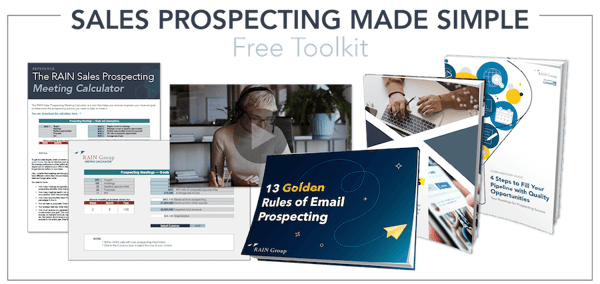How many touchpoints does it take to make a sale?
The simple answer is: more than most people think!
According to our Top Performance in Sales Prospecting research, it takes an average of 8 touchpoints to get an initial meeting (or other conversion) with a new prospect. But the initial meeting is just the beginning. It takes a lot more to make the sale.
You need to think of your sales and outreach efforts in 3 parts:
- Interest: Getting through to targeted buyers and securing an initial meeting to generate awareness and build interest.
- Consideration: Converting that meeting into a qualified opportunity.
- Commitment: Bringing the opportunity to a proposal and a win. (For tips on this, read how to write a proposal.)
There's a lot that goes on in each of these stages, and they tend to require frequent touches, outreach, and meetings with your buyers.
As a part of our research, we surveyed 489 sellers who outbound prospect. We studied their prospecting results, outreach methods, offers, and more. There's a significant difference in the results between Top Performers and The Rest in each stage of the sale.
Generating Meetings
While on average it takes 8 touchpoints to get through and generate a conversion, Top Performers can generate meetings with fewer touches. It takes Top Performers an average of 5 touches to generate a conversion. (Learn more about how to generate these meetings in our white paper, 5 Sales Prospecting Myths Debunked.)
Results from our study show Top Performers have better targeting, messaging, and value offers for meetings. This leads to more conversations and fewer touches to generate them.
Indeed, Top Performers convert 52 out of every 100 target contacts compared to The Rest, who convert only 19. That's 2.7x more meetings for Top Performers. Top Performers are also much more likely to say the meetings are high quality (100% vs. 55%).
What Makes a Quality Touchpoint?
Not all touches are created equal. Standing out amidst the noise is critical for crafting an effective touchpoint, and factors such as timing, medium, and brand presence are all relevant.
At its core, a quality touchpoint is built on buyer-focused value. To create that, you need to understand value from the buyer’s perspective:
- Why is taking action worth it?
- Why is taking action with urgency important?
- Why are you the best choice to talk to about something or buy something from?
- Why should they trust you? Are you credible for an initial conversation and an eventual purchase?
When planning your outreach and before you build any campaigns, you should know the 5 Ws:
- Who you're targeting
- What content your buyers want
- Where they want to hear from you
- When they want to hear from you
- Why they typically accept meetings
Part of crafting a quality touchpoint is understanding how to build trust with your potential buyers. While trust is a difficult thing to quantify, it’s essential to closing a sale. This is the downside of including a harder sell in your earlier touchpoints; you may not have the social capital necessary for a buyer to take your advice.
The key is understanding what your buyers value and integrating it into your touchpoints. Hard data, insight into industry trends, referrals or testimonials, and best practices are all potential trust-builders to incorporate into your outreach.
The Power of Attraction Campaigns
Once you have a good sense of the 5 Ws, you can leverage them to create attraction campaigns that best match your audience. The strength of an attraction campaign is that it gives you a rhythm to your outreach, allowing you to focus more on customization for individual buyers rather than the exact nature and schedule of your touchpoints.
Note than an attraction campaign will likely use a variety of touchpoints; a LinkedIn request isn’t likely to convert on its own, but it’s an important step in your larger strategy.
How Touchpoints Convert Meetings into Qualified Opportunities
Not all meetings result in a qualified opportunity. In fact, most initial meetings result in long-term leads or nothing at all. In our 2010 research on lead generation, approximately 25% of outbound leads generated were short-term and 75% were long-term, requiring an ongoing process to bring them to a qualified opportunity.
Read: 7 Steps to a Successful Sales Meeting When the Seller Drives Demand
Even if buyers don't perceive a need for your products and services—which would've prompted them to reach out themselves—they may desire the results you can help them achieve.
In fact, 7 out of 10 buyers want to hear from sellers when they’re looking for new ways to drive stronger business results—a compelling case to proactively build awareness and value for leads. It's up to you to educate and inspire buyers during your meetings and connect their goals with what you have to offer.
You may generate a qualified opportunity from just one meeting, but more often you inspire them with new possibilities and get them talking internally about new options for action they hadn't yet considered.
Because it typically takes multiple meetings to generate a qualified opportunity, the importance of perseverance in follow up to support your prospecting efforts cannot be overstated.
Number of Meetings, Conversations, or Demos to Generate a Qualified Opportunity

Finding the Ideal Number of Touchpoints for You
While 8 touchpoints is the average, there’s no hard and fast rule about how many touches you’ll need to convert a buyer. With all the noise in the modern sales environment, you may need more than 8.
A strong lead qualification system is critical to ensuring you’re spending the most effort on the most promising opportunities. Beyond that, the following factors might affect the number of touchpoints needed for any given lead:
- Industry, particularly trends and level of complexity
- Larger economic trends
- Your brand presence
- Buyer personas
- Whether the lead is warm or cold
- The extent of your personalization
- Where your lead is in their customer journey
- The length of your sales cycle
To determine the ideal number of touchpoints for any given lead, you need to do your research, know your buyers and offering, and be willing to adjust.
Bringing Opportunities to Proposal and Winning
Top Performers both secure more meetings and bring a higher percentage of them to proposal. Top Performers bring 56% of opportunities to proposal compared to only 46% of opportunities generated by The Rest. Top Performers also achieve significantly higher win rates on proposed business (48% vs. 37%).
The Top Performer Difference
Overall, Top Performers in Sales Prospecting are better at defining a strong value proposition for their meetings with buyers, targeting the right buyers at the right levels, and delivering first meetings that are both more customized and value-focused than The Rest. It's no wonder they generate more conversions in fewer touches, bring more opportunities to proposal, win opportunities more, and hit their goals more often.
But even for Top Performers, it takes more touches than they may initially think to close a deal.
Stay focused, persevere in your outreach efforts, and drive value for buyers in your sales conversations, and you'll see an increase in sales wins soon enough.








